5 Ground Zero
Tip: compare the dust clouds with a(n) [artificial] volcanic eruption

|
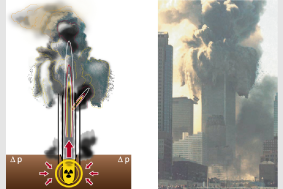
|
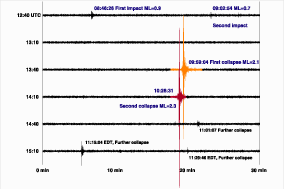
|

|
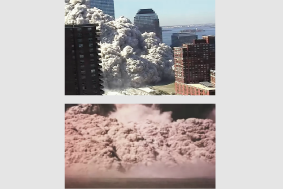
|
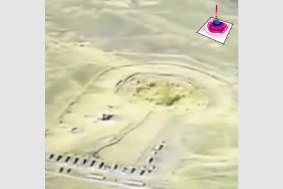
|

|

|
EXTERNAL LINK: (NOTE: we assume no liability for the contents)
Video clipping from ‘Ground Zero’
5.1 Checking the facts
5.2 Summary
5.2.1 Underground ignition: the pulse response
The needle-shaped soliton shooting up in the center
Field exercise in the US, radiation exposure relatively low due to the fact that the radiation is partly enclosed in the ground.
-
ESS Teapot: Blasting force 1 kt, 20 m under the surface

Source 1 @ 03:43:https://www.youtube.com/watch?v=9pjdwUYWGn0
Source
2:http://arxiv.org/abs/1309.3083v1
Detonation in a sandy subsoil
-
the characteristic and slightly elevated crater rim develops
In the case of explosions close to the topsoil, rock is not an adequate obstacle. Material is ejected eruption-like and compacted in a circular way at the edge:
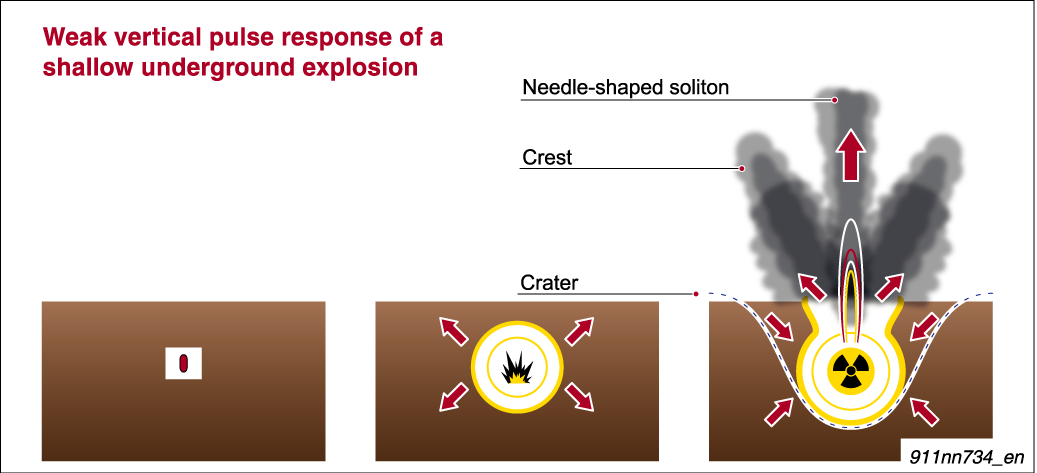
Source (edited): https://wikispooks.com/wiki/Nuclear_Demolition
Video clipping from ’Teapot ESS nuclear [1 kt / –20 m] detonation’
Source: https://www.youtube.com/watch?v=I9ahoAMAGL8
Detonation deeply underground: shaft sealed
-
a symmetrical distribution of the neutron flash (discharge of radiation energy)
-
a liquid rock bladder that seals the channel sound-proof
Pressure, heat and radiation cannot escape
A channel completely sealed by concrete results in:
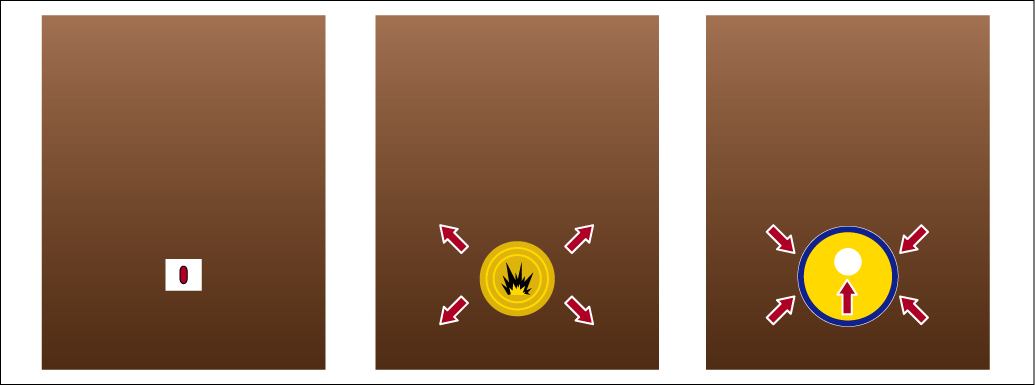
Source (edited): https://wikispooks.com/wiki/Nuclear_Demolition
Detonation deeply underground: shaft open
-
a vertical neutron flash (discharge of radiation energy)
-
a liquid rock bladder that seals the channel sound-proof
Pressure and heat cannot escape, radiation does escape
A channel left partly open results in:

Source (edited): https://wikispooks.com/wiki/Nuclear_Demolition
Video clipping from ’Underground nuclear explosion Sedan [104 kt / –194 m]’
-
Depth: 10 times the detonation depth of ESS Teapot
-
Blasting force 100 times the detonation depth of ESS Teapot
Source: https://www.youtube.com/watch?v=DcK3BdrjdiY
5.2.2 Ground Zero at the WTC
The needle-shaped soliton shooting up in the center
-
if however a channel is present that leads towards the explosive charge, the overpressure escapes like a shot from an oversized gun up to a height of more than 100 m
In the case of explosions taking place deeply underground, only a shock wave is registered.
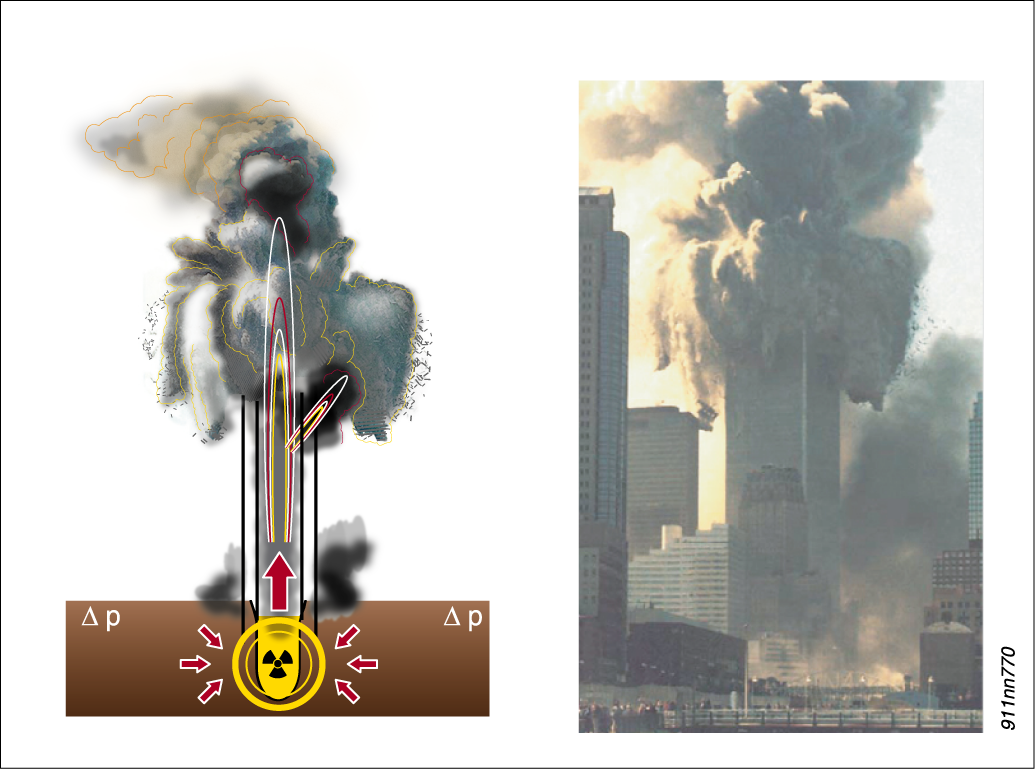
Source 1 (modified): https://wikispooks.com/wiki/Nuclear_Demolition
Source
2: http://911research.wtc7.net/wtc/evidence/photos/wtc1n1.html
Detonations on granite ground
-
extremely hard/strong
-
extremely short
The pulse (impact) of a nuclear explosion in the ground is:
“The result is the formation of a needle-shaped pulse response.
This standing wave is called soliton.”
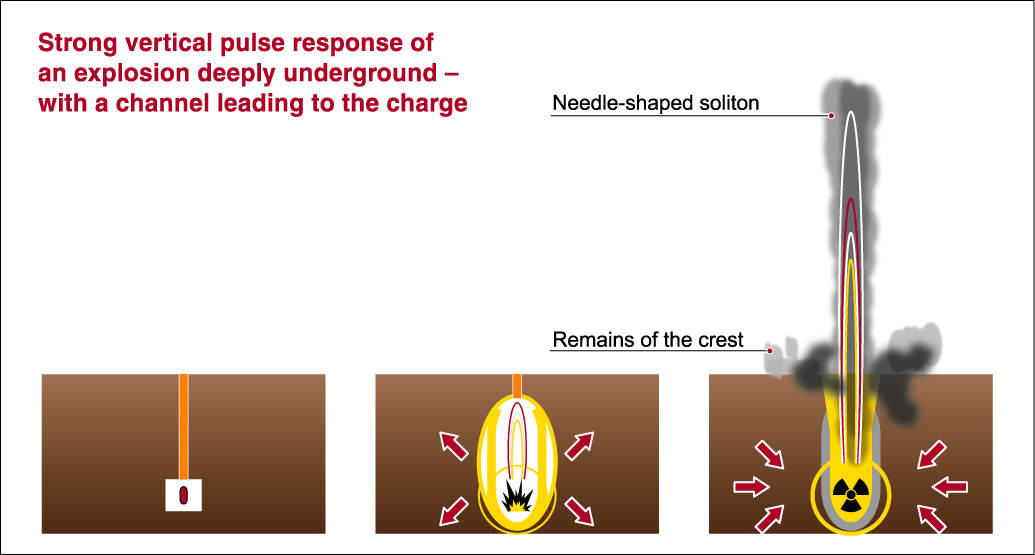
Source (edited): https://wikispooks.com/wiki/Nuclear_Demolition
5.2.3 Registered seismic shock wavers, energy and time curves
One seismic shock was registered for each of the three buildings.
A shockwave caused by an explosion always has the form of a sharp spike
|
Seismic wave of destruction of WTC-1 (red curve, amplitude 2.3) Seismic wave of destruction of WTC-2 (orange curve, amplitude
2.1) Local copy: |
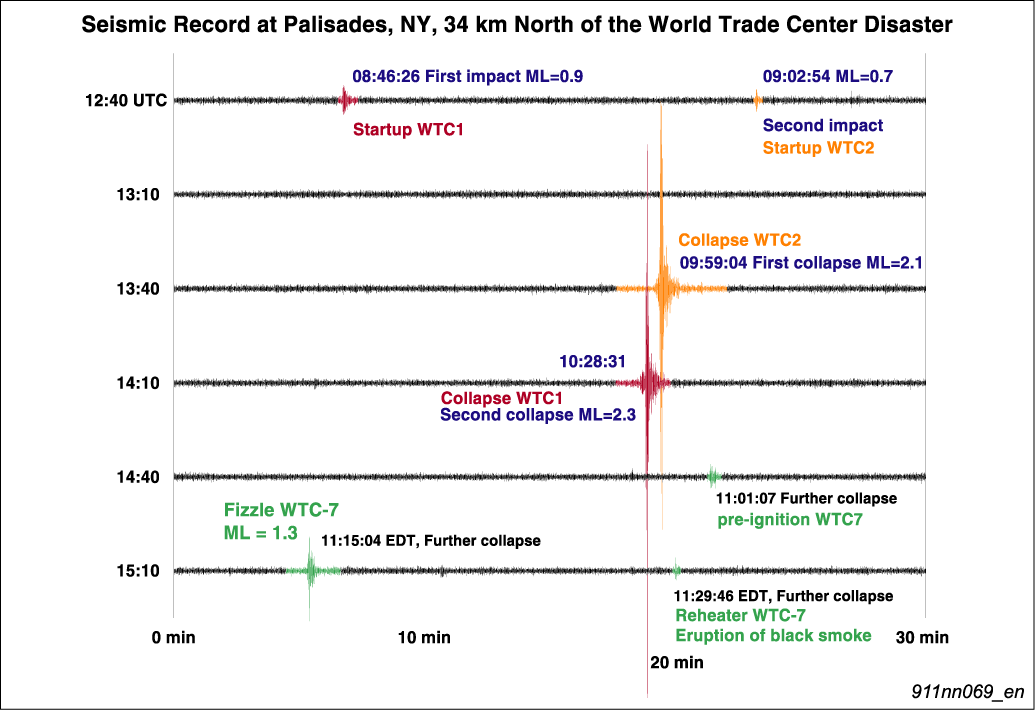
Source: http://www.ldeo.columbia.edu/LCSN/Eq/20010911_WTC/WTC_LDEO_KIM.pdf
DOWNLOAD
the svg file:www.911memorial4kids.org/svg/911nn069.svg
The shock wave for building 7 was registered but not made public

Source: http://www.ldeo.columbia.edu/LCSN/Eq/20010911_WTC/WTC_LDEO_KIM.pdf
Run for your life: Extract from ’Kevin McPadden WTC7 witness 9/11’
“...it was a distinct, individual sound, not like tha collapse of falling of stories ... it was like a rumble in the ground.”
Source: https://www.youtube.com/watch?v=49sBmAQBvms
Comparison: Ignition of a nuclear weapon deeply underground vs. earthquake

Energy and time plots
If an explosion takes place underground, the shockwave transfers a pulse into the rock earth, the pressure rises significantly until reaching the maximum.
-
the rock earth correspondingly responds with a shock wave as opposite pulse
This declining transfer of the pulse energy is a little slower than the absorption of the explosion energy as the energy store (the rock earth) has a high absorption capacity
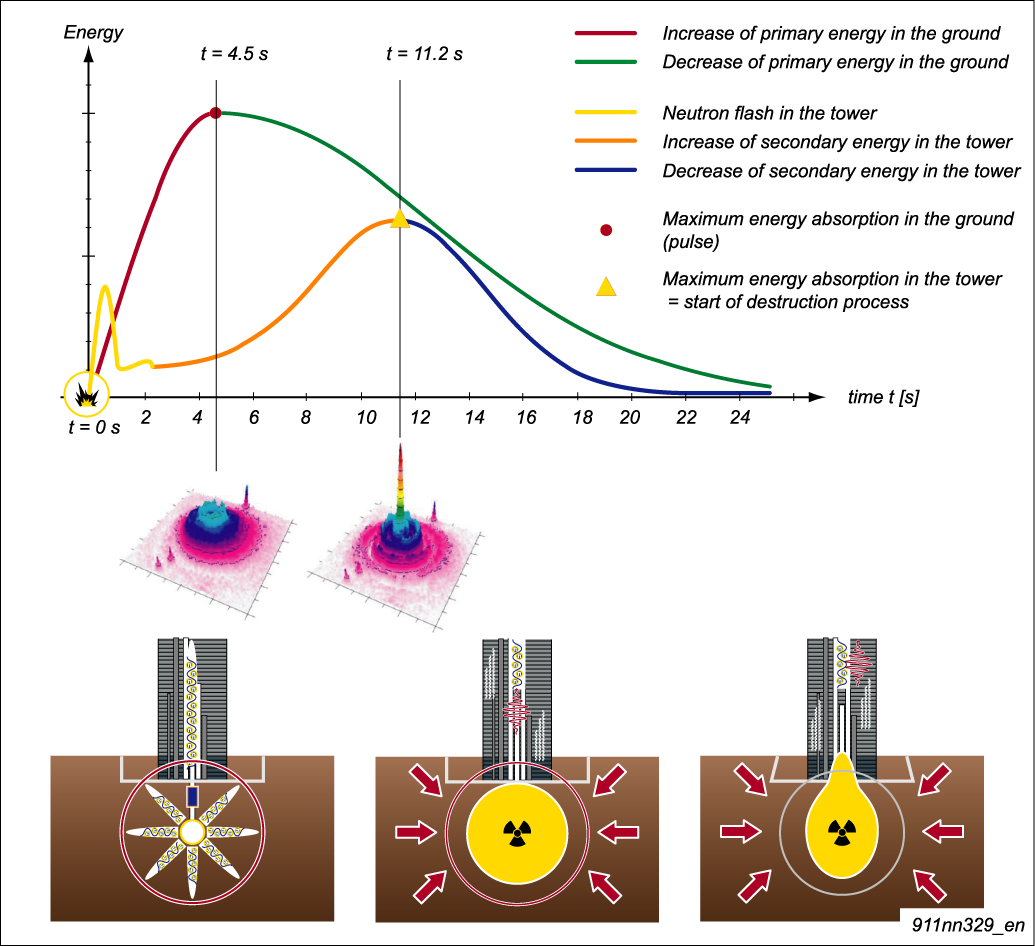
Source: http://www.ldeo.columbia.edu/LCSN/Eq/20010911_WTC/WTC_LDEO_KIM.pdf
DOWNLOAD
the svg file: www.911memorial4kids.org/svg/911nn329.svg
5.2.4 Material ejection behavior
In its appearance, the disintegration of the North Tower on 9/11 resembles the material ejection behavior of a nuclear weapon detonated in a flat underground (blasting force approx. 100 kt).
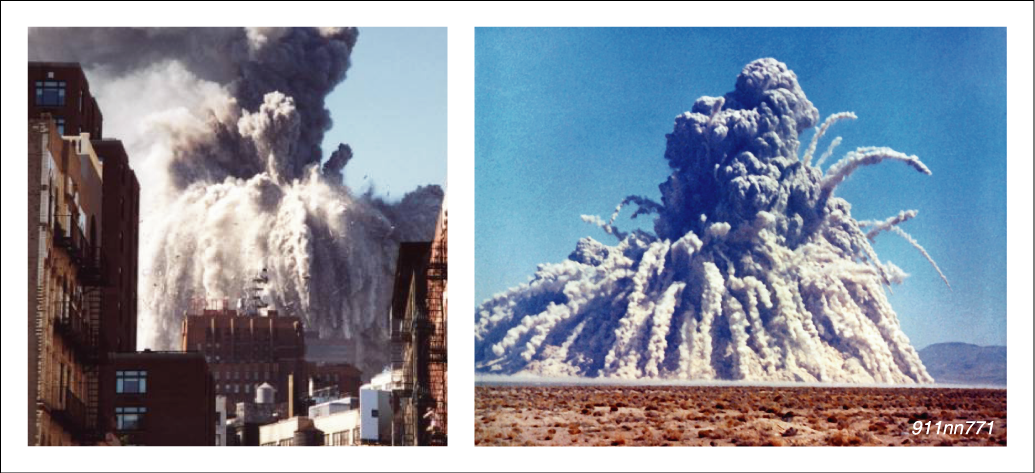
Source 1: http://911research.wtc7.net/wtc/evidence/photos/wtc1exp10.html
Source
2: https://en.wikipedia.org/wiki/Sedan_(nuclear_test)
Conservation of momentum: ONE center of energy underground
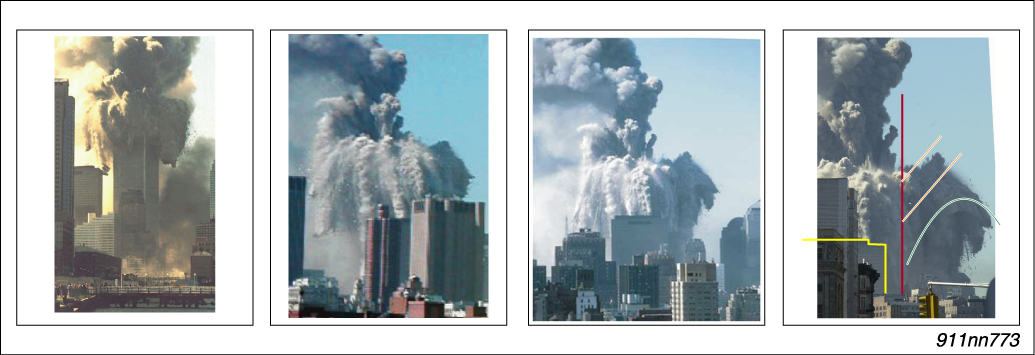
Source: http://911research.wtc7.net/wtc/evidence/photos/wtc1exp10.html
Example 1
If a drop of blue ink drips into a cup of milk, the drop transmits a pulse to the surrounding liquid, the milk.
-
the milk’s reaction is a needle-shaped shockwave

Source: http://en.wikipedia.org/wiki/Drop_%28liquid%29#mediaviewer/File:Blue_Droplet.jpg
Example 2
If an explosion takes place underground, the shock wave transmits a pulse to the rockbed
-
the rock earth responds with a shockwave as reaction that is needle-shaped in the case of ground-level explosions
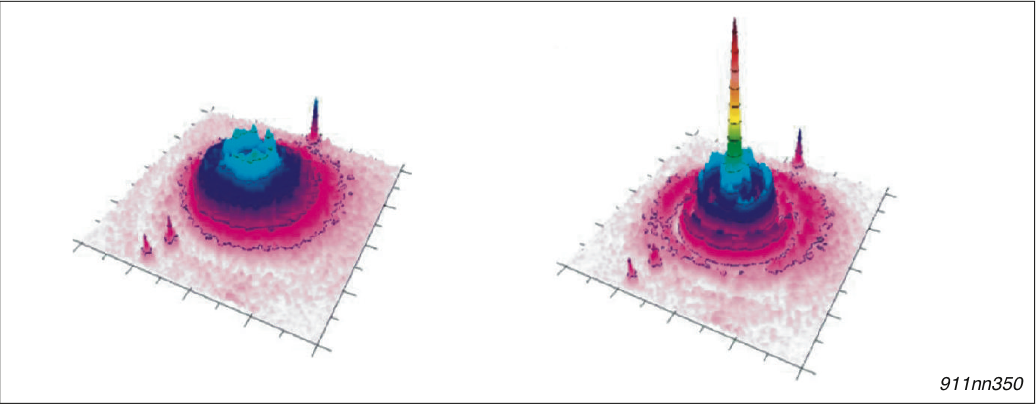
Source: http://arxiv.org/abs/1309.3083v1
5.2.4.1 Experiment to demonstrate the processes
Instead of a steel construction, a destructive 3,000 °C hot upshooting plasmatic needle and high pressures, the home experiment uses the following utensils:
-
a thin-walled, hollow block of ice (– 10 °C)
-
hot water (80 °C)
-
steam nozzle from a coffee maker
-
small fountain pump
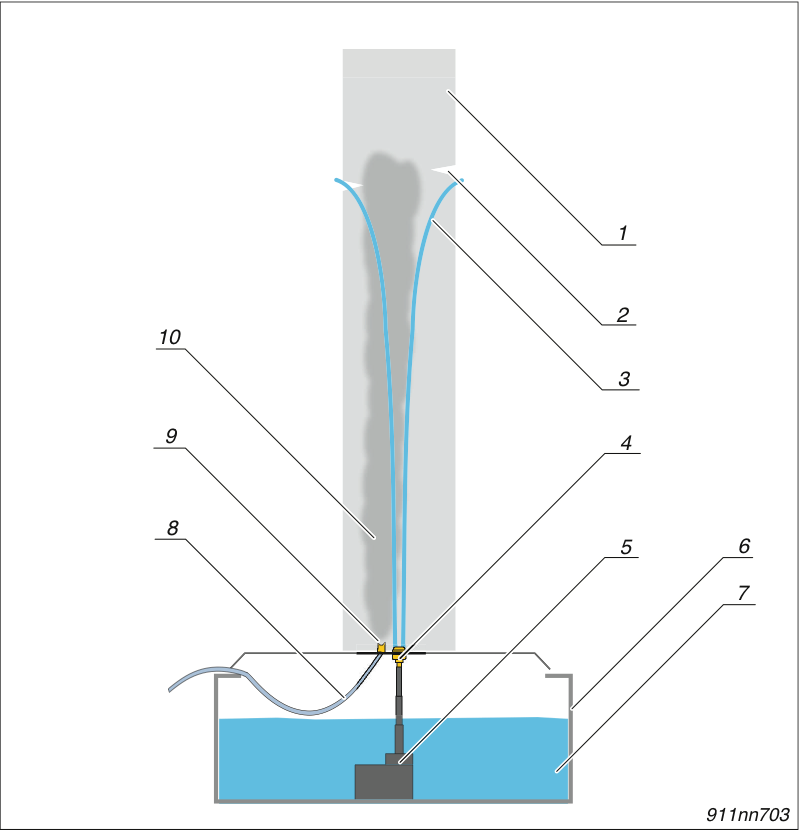
Experiment set-up Disintegration of an ice tower (uncontrolled)
1. Hollow block of ice
2. Cut-off opening
3. Hot water fountain
4. Fountain mouthpiece
5. Battery-operated pump
6. Water tank
7. Hot water
8. Steam tube of a coffee maker
9. Steam tube mouthpiece
10. Steam rising up
Preparation
A battery-operated fountain pump that can be regulated via a potentiometer is positioned in a water tank.
A small board with boreholing in the middle is used as cover, it does not inhibit the upshooting fountain from propagating.
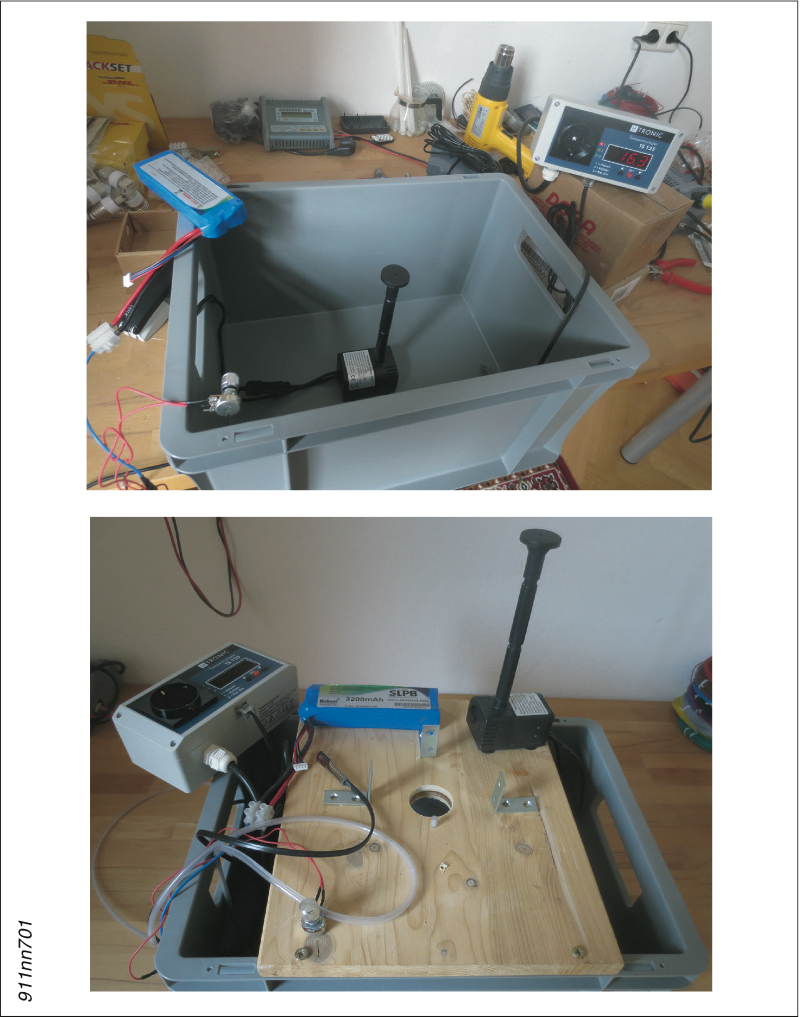
Experiment set-up components
Installation
The picture shows a water basin with a fountain of hot water shooting up through the cover plate while steam is constantly ejected at the same time.
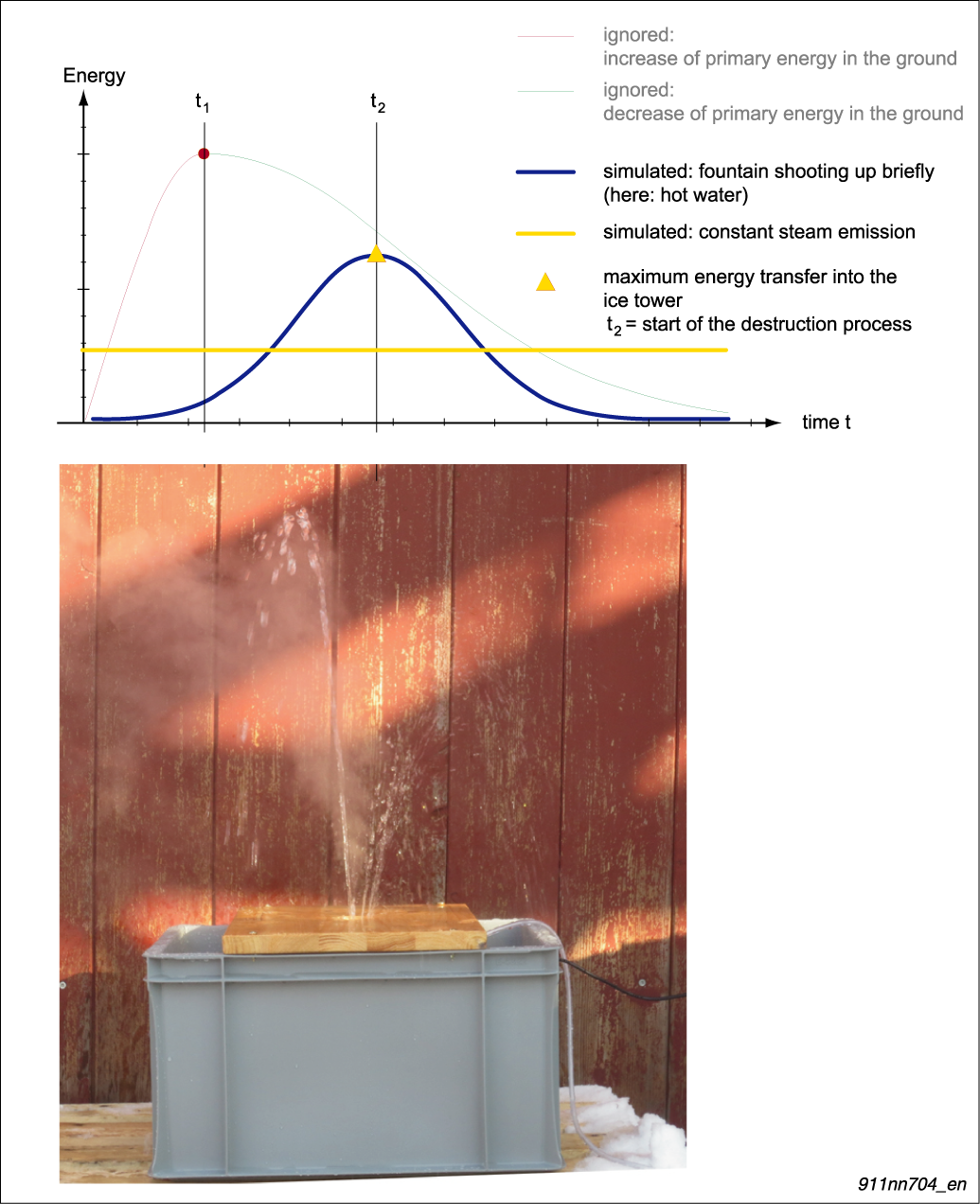
Water fountain shooting up and constant steam ejection from “underground”
Experimental procedure
-
Ice block in position, steam flow constant, upshooting water fountain
-
The opening in the upper quarter widens quickly and allows the hot water to eat its way upwards into the ice
This destabilizes the upper part
-
At the same time, the ice block is sinking because a part of the hot water flows down on the inside and also dissolves the structures underneath
-
Finally the top breaks off and the residual block tips to the side
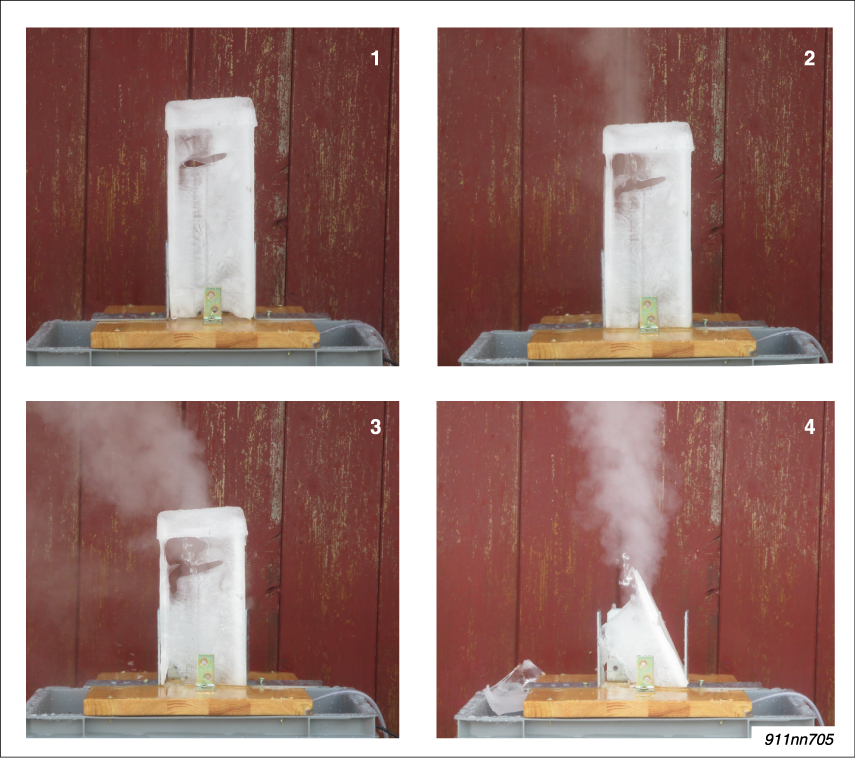
Experimental procedure: Melting / destruction of the ice block
Comparison / interpretation
-
for WTC 7: Destruction as collapsing building (sagging)
-
for WTC 1 / WTC 2: Destabilization of the spire; residual structures
For a block to get destroyed from top to bottom as “standing unit”, the energy must be controlled more precisely (encapsulation on the inside).
The experiment set-up reflects two patterns observed on 9/11:
5.2.5 Wave front of a hot solids-gas-dispersion
The wavefront of the dust cloud consisting of iron microspheres and pulverized concrete, resembled in its movement a pyroclastic flow (hot solid-gas dispersion).
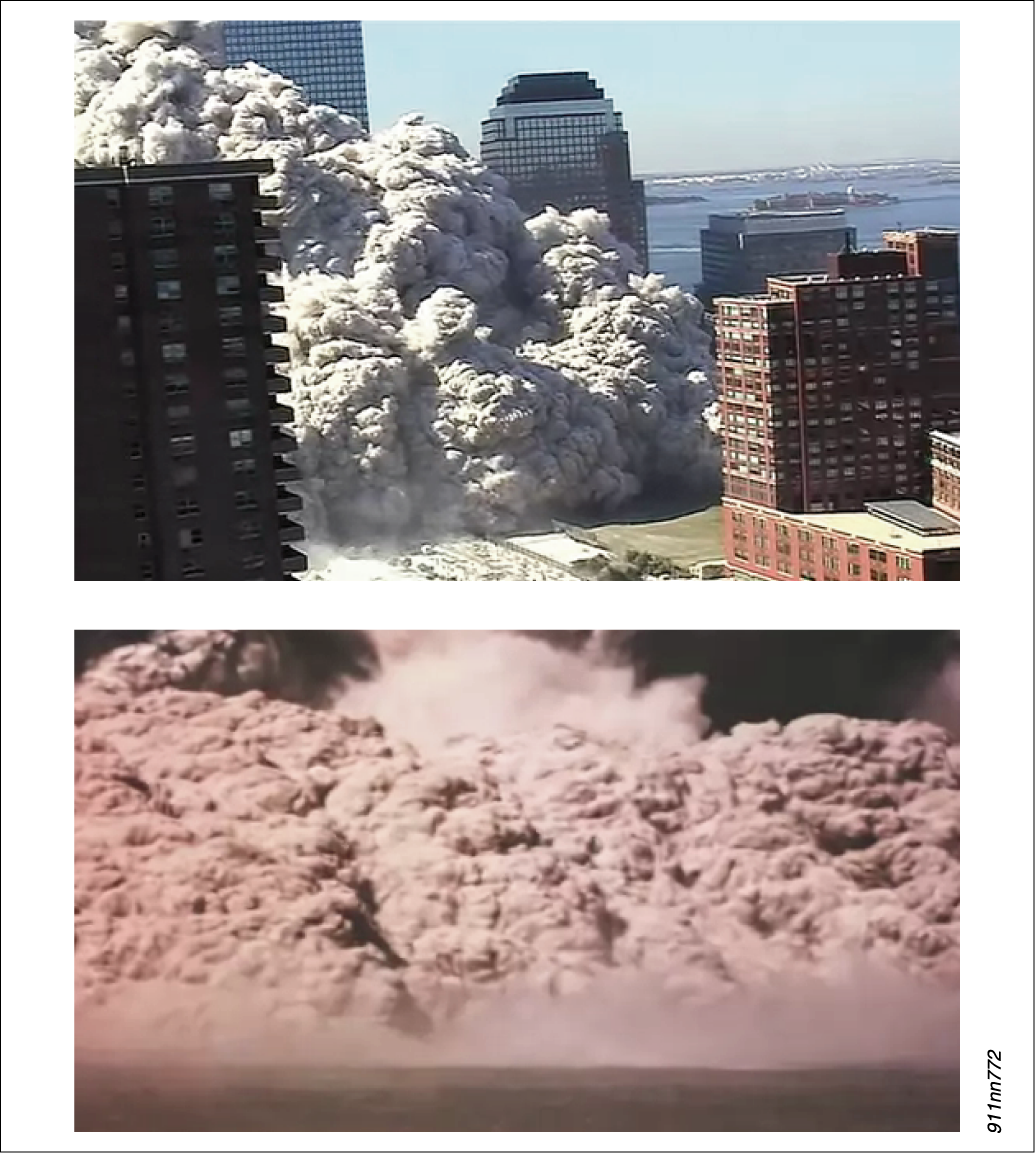
Source 1 @27’:06’’: http://www.youtube.com/watch?v=eEwSHkQvTI8
Source
2 @ 00’15’’: https://www.youtube.com/watch?v=dyMegAfUqxs
THE 9/11 TORONTO REPORT
|
According to the reports, the dust cloud was scorching hot and people got burned. Local copy: |
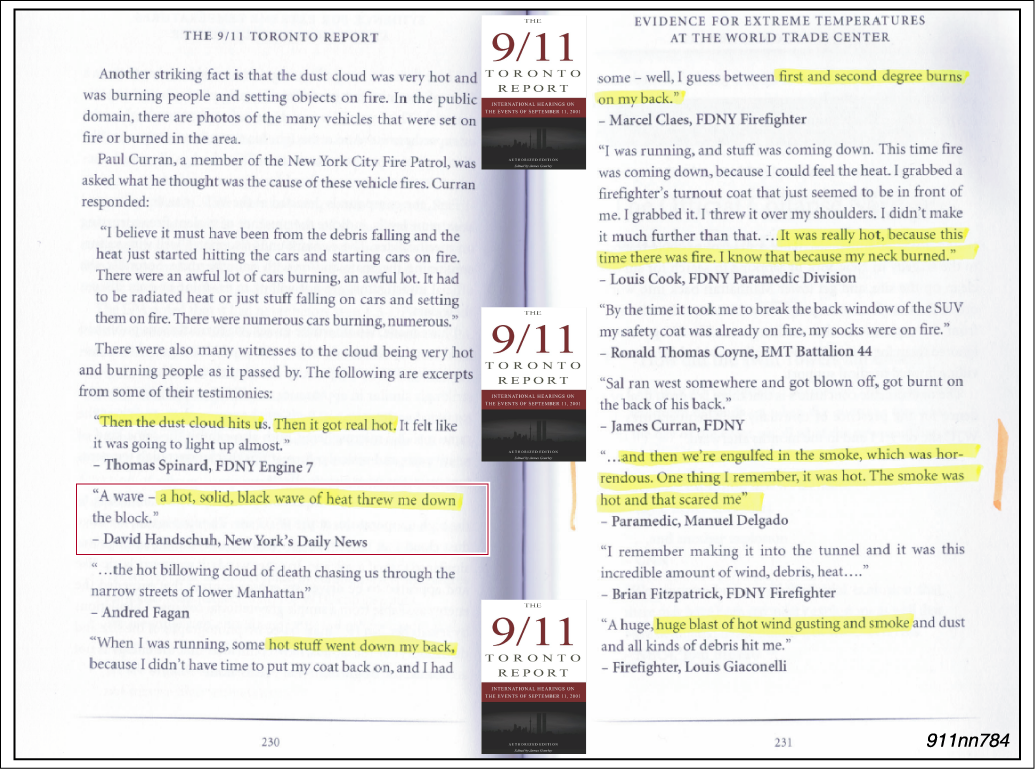
Source: THE 9/11 TORONTO REPORT (page 231/232)
THE 9/11 TORONTO REPORT, page 230; New York’s News; David Handschuh
German
“A wave – a hot, solid, black wave of heat threw me down the block.”
THE 9/11 TORONTO REPORT, page 231; Paramedic; Manuel Delgado
German
“... and then we were engulfed in the smoke, which was horrendous. One thing I remember, it was hot. The smoke was hot and that scared me.”
DOWNLOAD extract from the source: http://www.911memorial4kids.org/pdfs/Toronto_Report_p_230.pdf
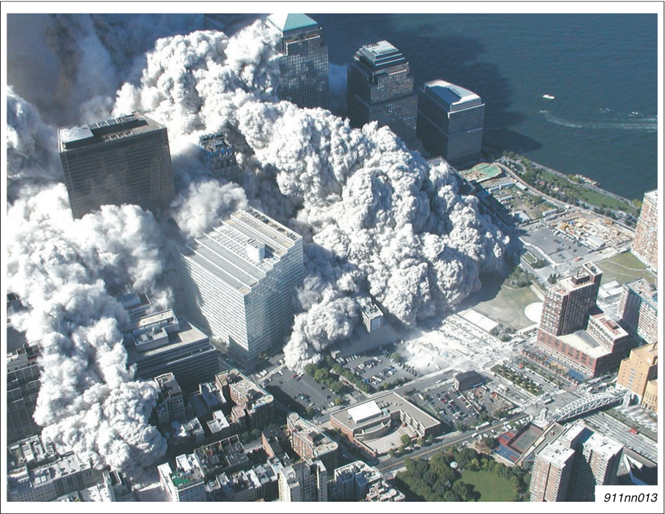
Source: http://911research.wtc7.net/wtc/evidence/photos/wtcdust3.html
5.2.6 Cavitation and outbursting fireball
With the onset of the South Tower’s destruction process, the road in front of the tower subsided and released a fireball.
Video clipping from ’9/11: WTC ground level fireballs ’
Source: https://www.youtube.com/watch?v=e3qFh7IMizk
Gas outburst at the South Tower
Heavy white smoke coming out of all sides of the lobby before any debris hit the ground.
Heavy white smoke coming out of all sides of the lobby before any debris hit the ground.

Source @48:26: https://www.youtube.com/watch?v=l0Q5eZhCPuc
9/11
- Anatomy of a Great Deception – Complete Version
Example 1: Sagging of the ground without the outburst of a fireball
The example shows the consequences of a nuclear explosive charge positioned at a relatively great depth – without channeling the energy upwards.
-
noticeable cavitation (subsidence of the ground)
-
minor pulse response of the ground (needle shooting up in the middle)
Observation:
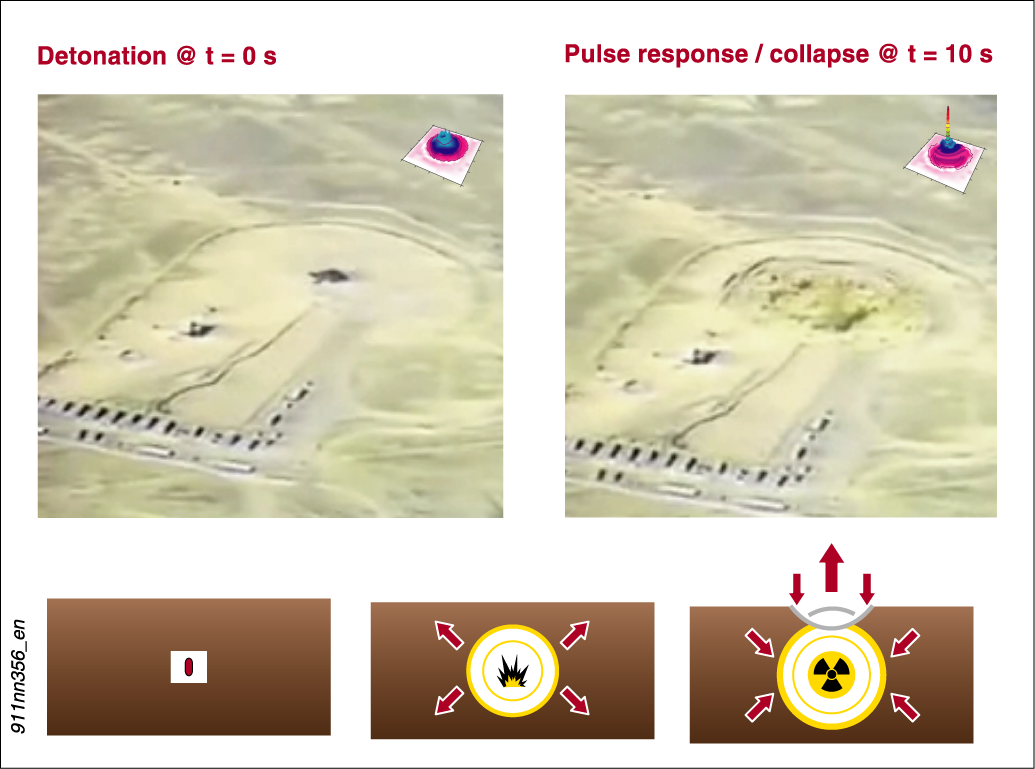
Source 2 (@0:45 / @ 1:27): https://www.youtube.com/watch?v=RE4pwEjPTVc
Example 2: Outburst of a fireball
The example shows the consequences of a nuclear explosive charge positioned at a relatively great depth.
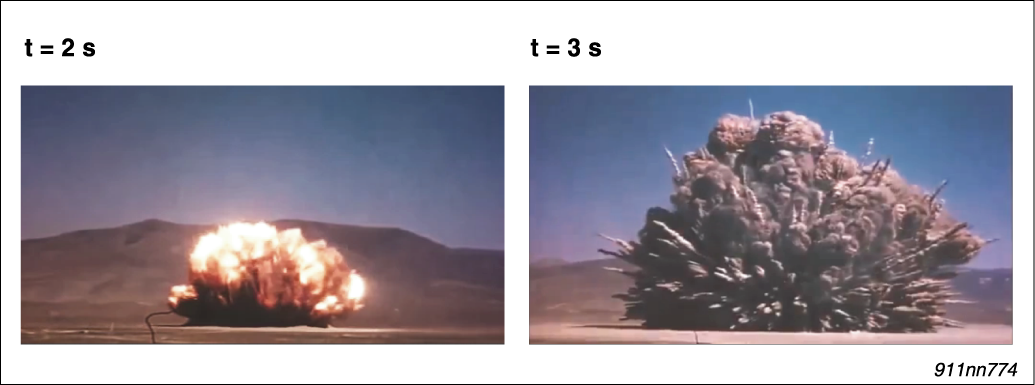
Source @ 00’03’’ / 00’:06: https://www.youtube.com/watch?v=dyMegAfUqxs
-
Outburst of a fireball
-
goes out immediately, precursor shooting out of the mushroom cloud
Observation:
Video clipping from ’Storax Sedan underground nuclear test in Area 10 of Yucca Flat’
Source: https://www.youtube.com/watch?v=dyMegAfUqxs
5.2.7 Mushroom clouds, rotating tubes, cloud stem and spherical clouds
Rotating cloud tube rising up after detonation of the bomb
Field exercise in the US, high radiation exposure due to direct influence of the radioactive radiation.
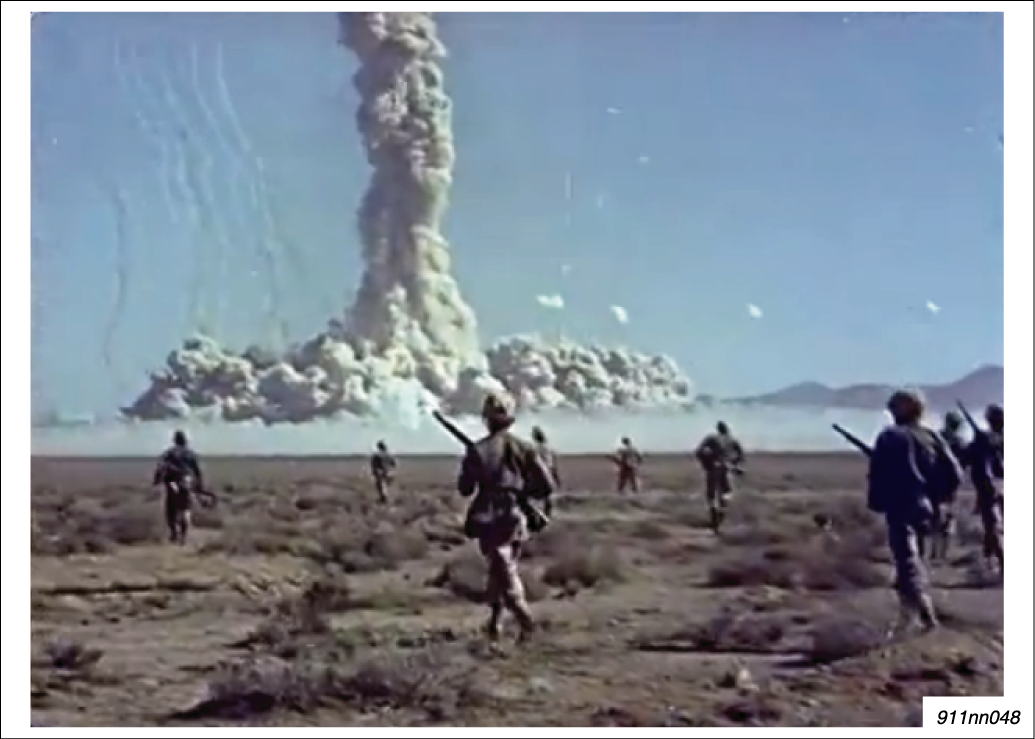
Standing cloud stem
After the nuclear weapon had been ignited with 24 kt,
the cloud stem rose up to a height of 1250 m
https://en.wikipedia.org/wiki/Operation_Upshot%E2%80%93Knothole.

Source: http://commons.wikimedia.org/wiki/File:Upshot-Knothole_Nancy_001.jpg
Formation of a vortex hose during high-energy explosions
The friction zone between hot and cold air tends to develop rotation and condensation phenomena (white, bell-shaped or tubular, partly rotating forms).

Source 1: http://en.wikipedia.org/wiki/Vortex / source 2: https://www.flickr.com/photos/epicfireworks/3542212906/
Material ejection pattern of a shallow underground nuclear explosion
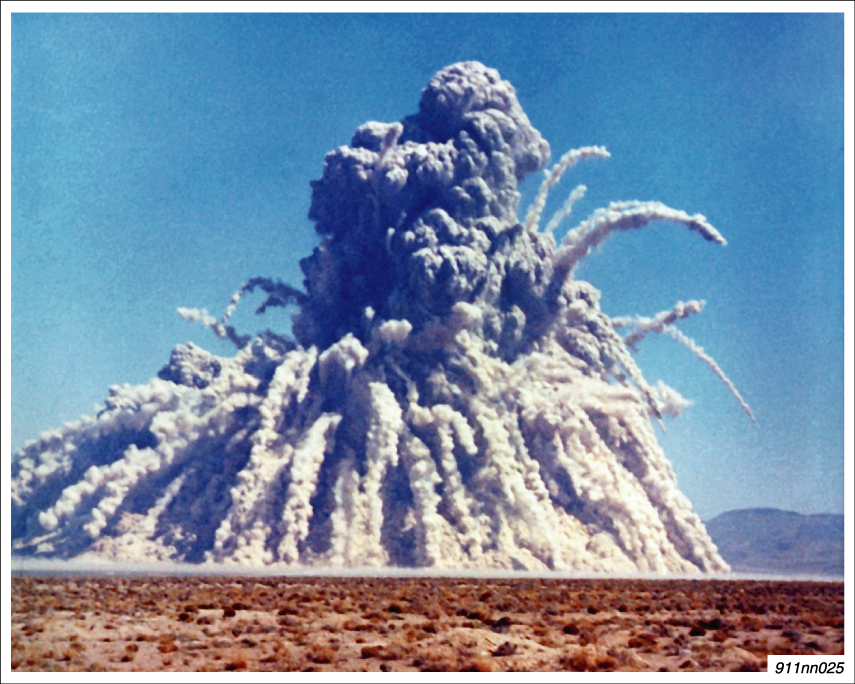
Source: http://en.wikipedia.org/wiki/Sedan_%28nuclear_test%29
Underdeveloped mushroom head above the destroyed North Tower
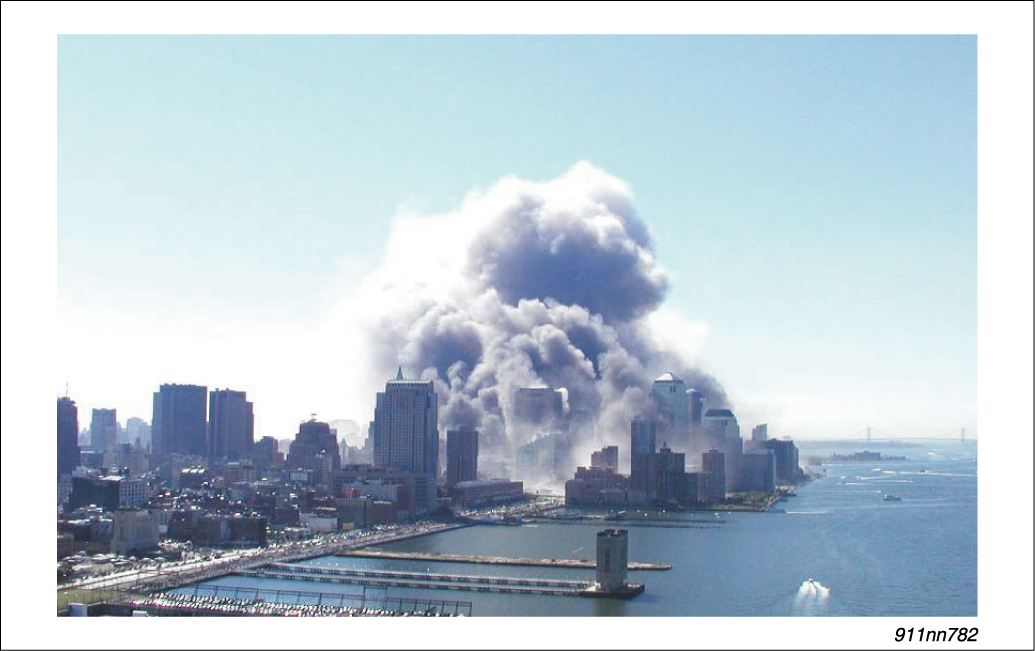
Source: Source: https://www.facebook.com/911nucleardemolition/photos_stream?tab=photos_stream
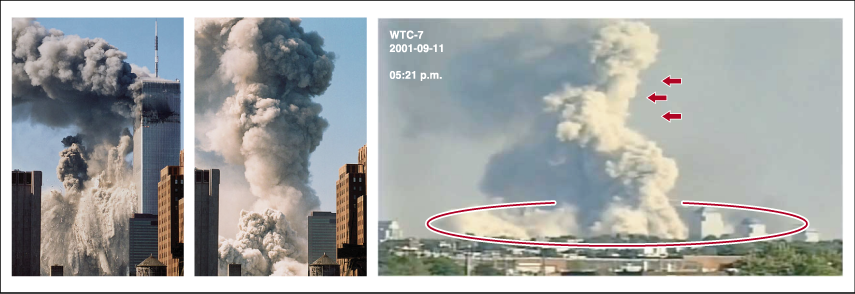
Source @05:35: http://www.youtube.com/watch?v=JnLcUxV1dPo
Vulcano-like eruptions
List of references: see below (35; 33; 34; 36; 37; 54; 55; 15; 61; 01; 02; 05; 06)
5.2.8 Borax test series
In the US, a number of reactors were run supercritically and blown up deliberately for test purposes, the emerging radioactive fallout was downplayed.
Borax test series
Test reactor Borax II in supercritical condition – prior to the intended explosion.

Source (page 19; http://www.ne.anl.gov/): Story-of-BORAX-Reactor-by-Ray-Haroldsen-v2.pdf
Local
copy: http://www.911memorial4kids.org/pdfs/Story-of-BORAX-Reactor-by-Ray-Haroldsen-v2.pdf
Test reactor Borax II during the explosion (after the ejection of the neutron control rods)

Source (page 29; http://www.ne.anl.gov/): Story-of-BORAX-Reactor-by-Ray-Haroldsen-v2.pdf
Local
copy: http://www.911memorial4kids.org/pdfs/Story-of-BORAX-Reactor-by-Ray-Haroldsen-v2.pdf
5.3 Photo gallery
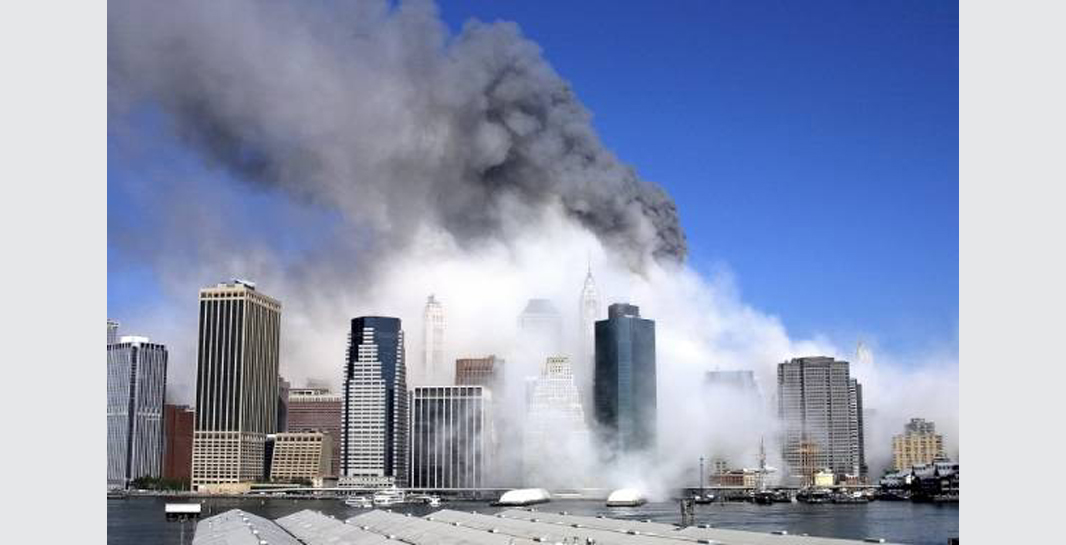

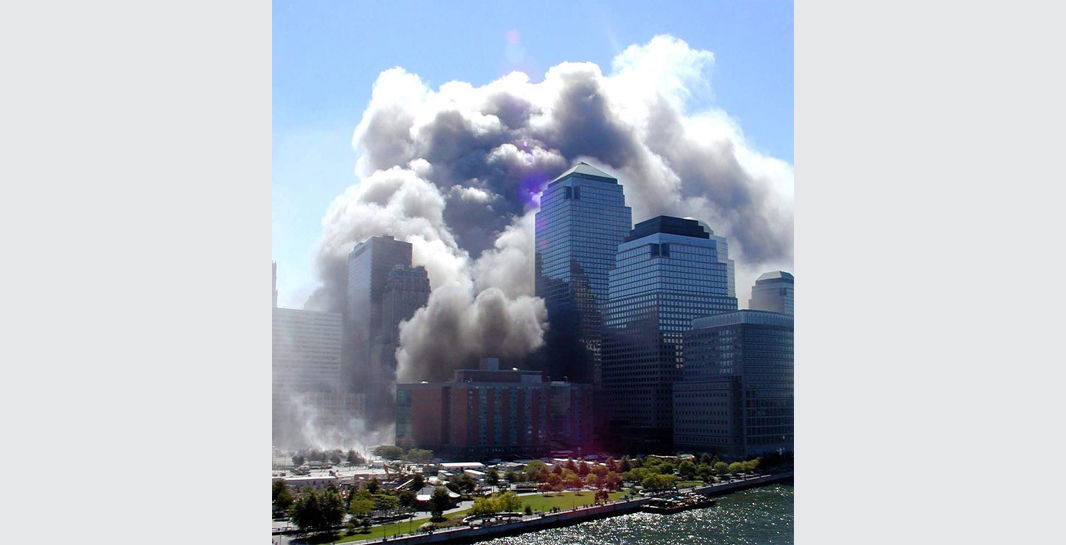
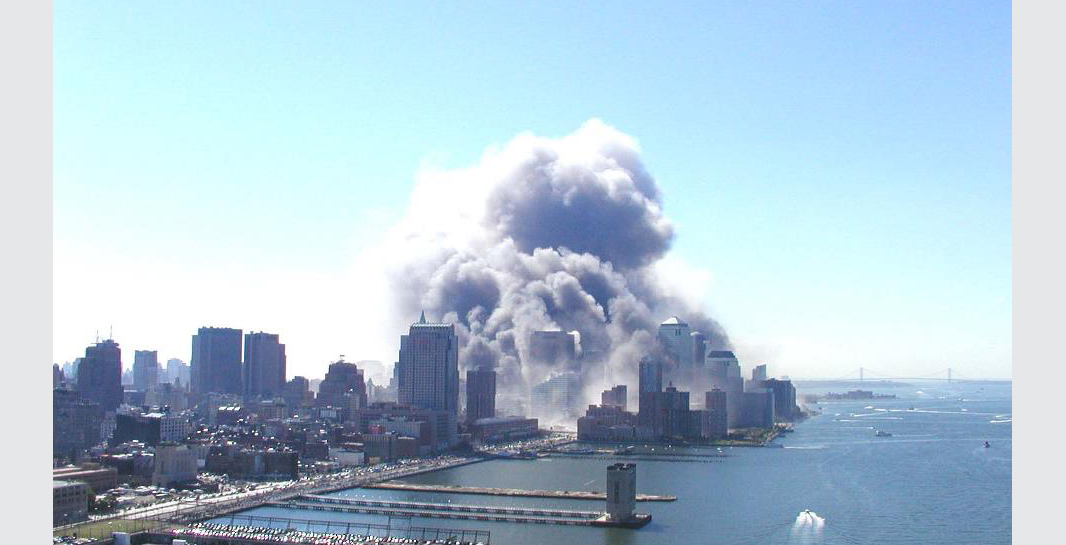

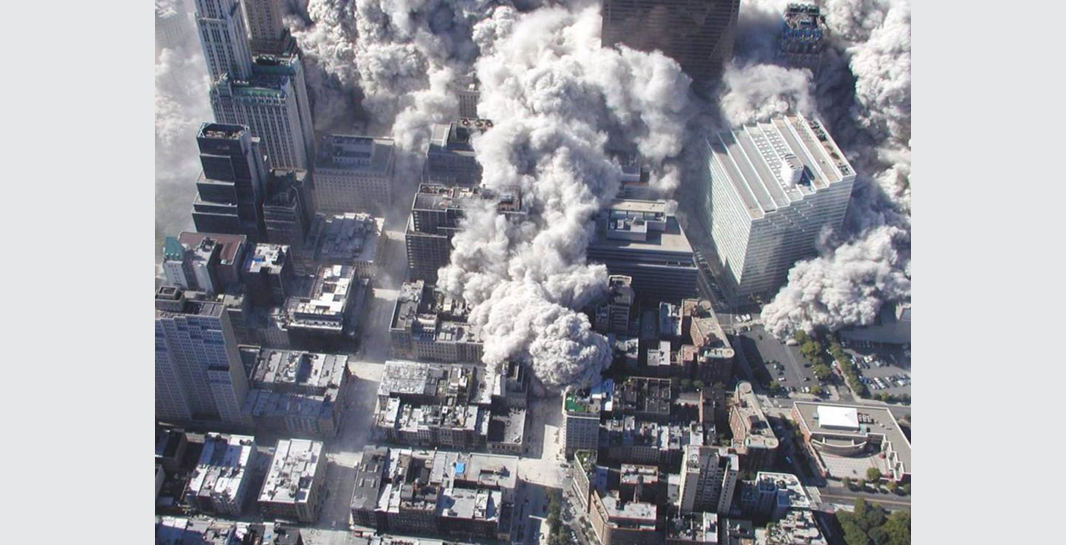
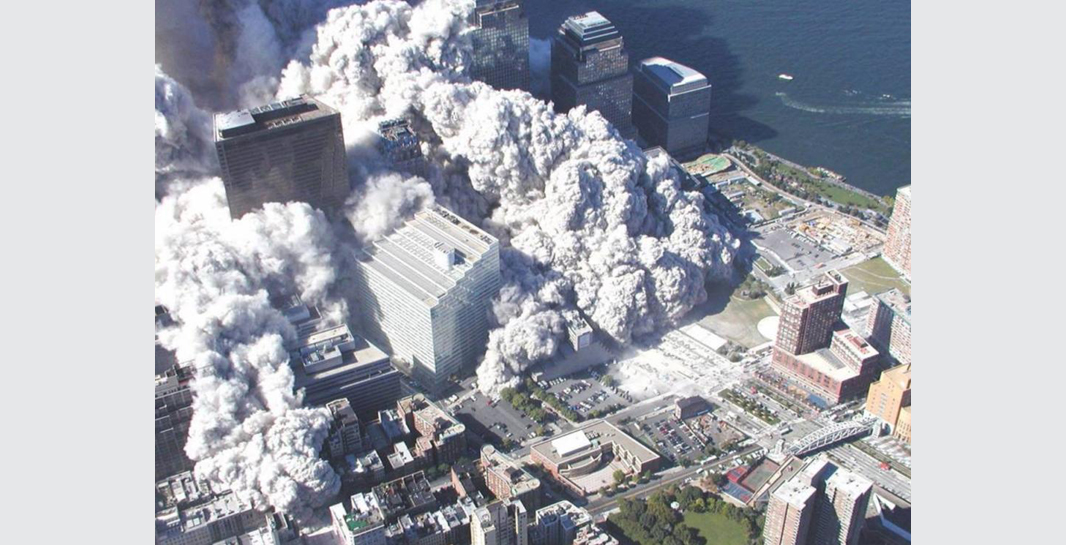

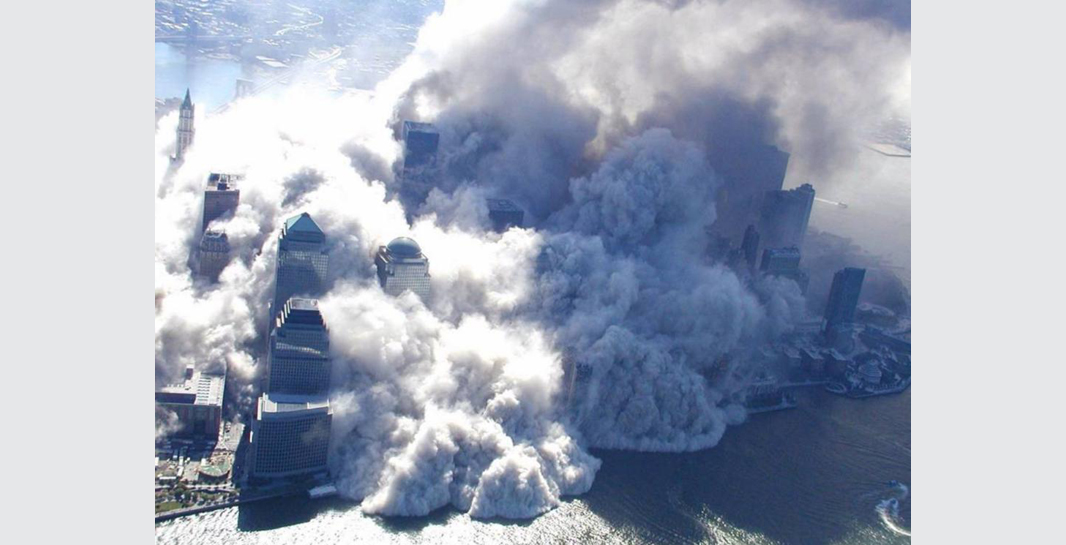
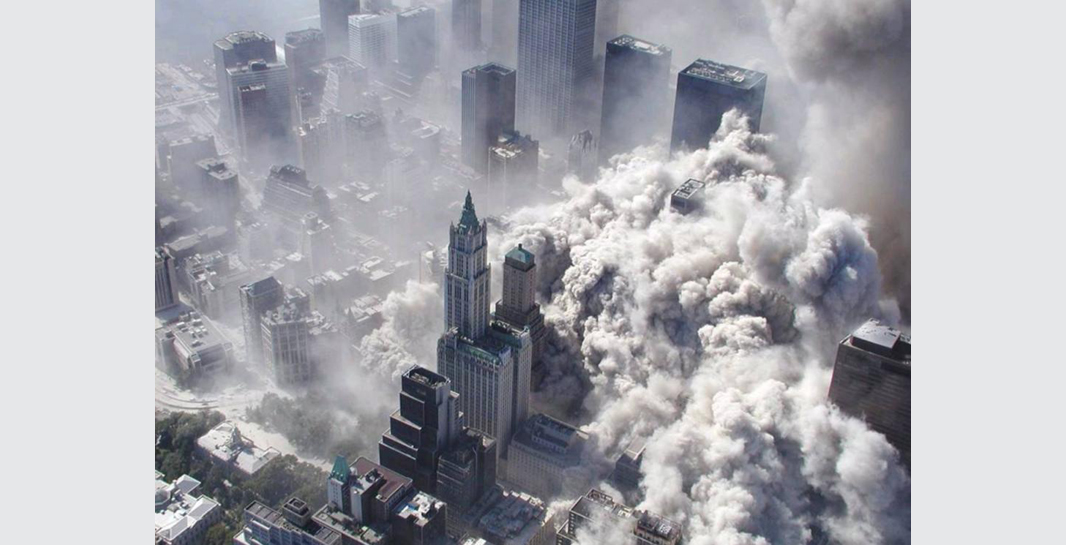

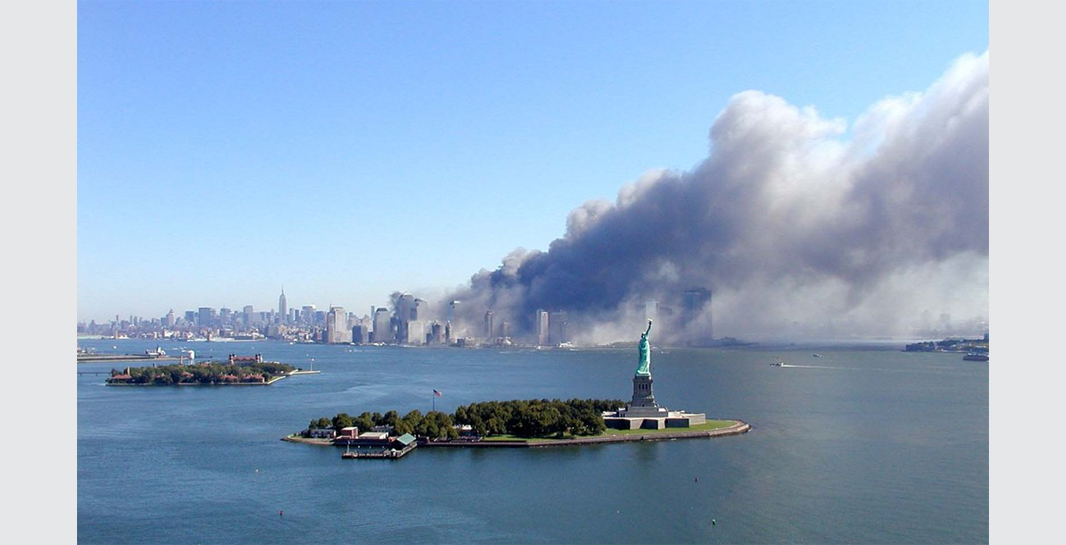
Source 1: https://www.facebook.com/911nucleardemolition/photos_stream?tab=photos_stream
Source 2: http://911research.wtc7.net/wtc/evidence/photos/index.html
5.4 References
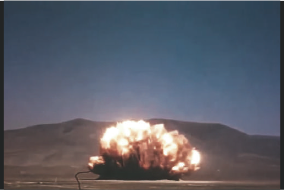 |
The Storax Sedan test was conducted in area 10 on the Nevada Test site on july 6th 1962 (Operation Plowshare: 104 kt yield; –194 m) @ 00:03: emerging fireball from below the earth ShortClip: https://www.youtube.com/watch?v=bE5eXzWuAJ4 |
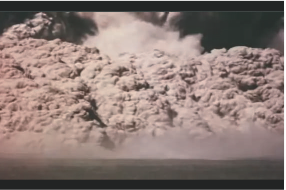 |
The Storax Sedan test was conducted in area 10 on the Nevada Test site on july 6th 1962 (Operation Plowshare: 104 kt yield; –194 m) @ 00:15: pyroclastic dust wave of pulverized rock ShortClip: https://www.youtube.com/watch?v=A8b4eH8cBrw |
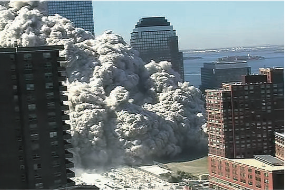 |
WTC2 Fireball / WTC1 Core Remnant / WTC7 Burning & Rubble @ 27:06: pyroclastic dust wave of pulverized rock, concrete and steel ShortClip: https://www.youtube.com/watch?v=UOTaFwaKrW4 |
 |
Footage shows good characteristics of the rotating nuclear stem (vortex), slowly rising and turning mushroom cloud, pyroclastic dustwave on ground level and thin haze of evaporated ground elements. @ 03:00: ignition @ 03:12: fireball turning from yellow to orange @ 03:27: shockwave arrives at the trenches @ 03:27: soldiers leave trenches and start to walk towards the center of explosion, vortex stem slowly rotating ShortClip: https://www.youtube.com/watch?v=XrNBF69ZGUE |
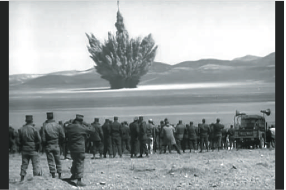 |
Footage shows the training of soldiers – theory and real maneuver . @ 03:43: ignition, testing @ 03:59: theorie of a nuclear blast ShortClip: https://www.youtube.com/watch?v=OjkL9QkvXPE |
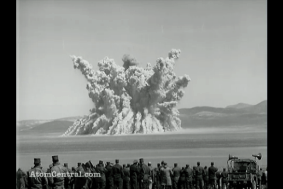 |
ESS was a 1 kiloton nuclear blast. ESS, short for "Effects Sub Surface" was detonated at –20 meters on March 23, 1955 This footage is silent. ShortClip: https://www.youtube.com/watch?v=YML8wJS5DbA |
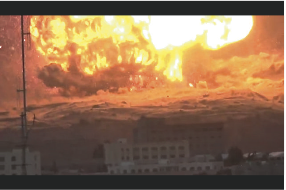 |
Footage shows good characteristics of a small bunker buster nuclear charge. @ 00:08: penetration and explosion of pre-charge @ 00:14: in-depth ignition @ 00:36: interaction of charged particles / radiation with the pixels of the camera ShortClip: https://www.youtube.com/watch?v=GRzu6WKYkUg |
 |
Footage shows good characteristics of a small bunker buster nuclear charge. @ 00:10: penetration and explosion of pre-charge @ 00:16: in-depth ignition @ 00:27: interaction of charged particles / radiation with the pixels of the camera ShortClip: https://www.youtube.com/watch?v=9IcM4eyanEo |
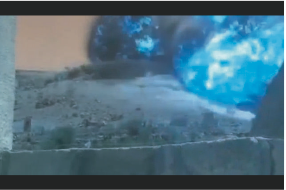 |
Footage shows good characteristics of a small bunker buster nuclear charge. @ 00:18: blue light emission @ 00:19: camera short-circuiting ShortClip: https://www.youtube.com/watch?v=zISZLHxPIaI |
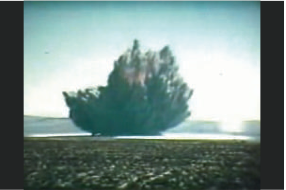 |
Storax Sedan was a shallow underground nuclear test conducted in Area 10 of Yucca Flat at the Nevada Test Site on 6 July 1962 as part of Operation Plowshare: 104 kt yield; –194 m. @ 00:07: ignition at Ground Zero @ 00:19: good view of outshooting squibs ShortClip: https://www.youtube.com/watch?v=wqE6PYxT9ao |
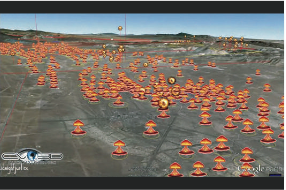 |
The United States nuked the United States. @ 26:55: This is Nevada! Check at http://www.climateviewer.org/ ShortClip: https://www.youtube.com/watch?v=i5mAgHXSB4k |
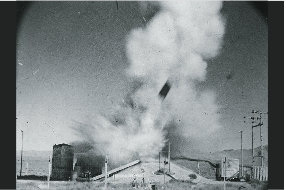 |
Experiment of how to blow up a nuclear reactor and EMP impuls @ 14:28: "the cameras stopped because of interruption of their electric power before the end of the explosion" BORAX-I Destructive Test and Cleanup: ShortClip: https://www.youtube.com/watch?v=UQ-V5pJMss8 |
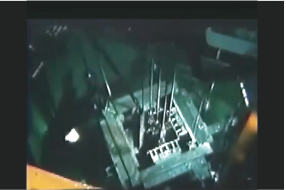 |
Experiment of how to blow up nuclear reactor and EMP impuls @ 05:06: "the first close view of the reactor building showed that one of the roof beam had been blown updwards (...) by some component ejected from the reactor vessel" SPERT Destructive Test and Cleanup: ShortClip: https://www.youtube.com/watch?v=BFh38NpWtNM |